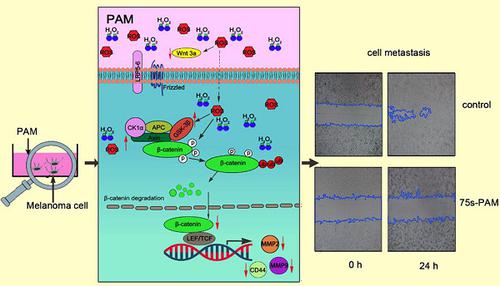当前位置:
X-MOL 学术
›
Plasma Processes Polym.
›
论文详情
Our official English website, www.x-mol.net, welcomes your
feedback! (Note: you will need to create a separate account there.)
Low‐temperature plasma‐activated medium inhibited invasion and metastasis of melanoma cells via suppressing the Wnt/β‐catenin pathway
Plasma Processes and Polymers ( IF 2.9 ) Pub Date : 2019-09-20 , DOI: 10.1002/ppap.201900060 Jin‐Ren Liu 1 , Ling‐Ge Gao 1 , Yue‐Ming Wu 1 , Gui‐Min Xu 2, 3 , Yan Ma 1 , Yue Hao 1 , Xing‐Min Shi 1 , Guan‐Jun Zhang 3
Plasma Processes and Polymers ( IF 2.9 ) Pub Date : 2019-09-20 , DOI: 10.1002/ppap.201900060 Jin‐Ren Liu 1 , Ling‐Ge Gao 1 , Yue‐Ming Wu 1 , Gui‐Min Xu 2, 3 , Yan Ma 1 , Yue Hao 1 , Xing‐Min Shi 1 , Guan‐Jun Zhang 3
Affiliation

|
Low‐temperature plasma (LTP) has shown promising and potential applications in the field of biomedicine. The effects of the plasma‐activated medium (PAM) inhibiting tumor cell invasion and metastasis have been verified, but the associated molecular mechanisms are poorly understood. The aim of this study was to identify the anti‐invasion and antimetastasis effects and mechanism induced by PAM on B16 melanoma cells cultured in vitro. For this purpose, an atmospheric pressure plasma jet in helium was applied to generate PAM to treat B16 cells. Cell invasion and migration assays showed that PAM exerted an inhibitory effect on B16 cell invasion and migration in a time‐dependent manner. Then, detection of the invasion‐ and metastasis‐related proteins, including matrix metalloproteinase (MMP)‐2, MMP‐9, CD44, and E‐cadherin, showed that their changes accorded with the invasion and metastasis of the PAM‐treated B16 cells. Furthermore, the Wnt/β‐catenin pathway‐related proteins in PAM‐treated cells were measured, and the pathway was found to be suppressed by PAM. Finally, numerous specific reactive oxygen species (ROS) scavengers were applied to eliminate LTP‐induced ROS in PAM, and it was revealed that H2O2 played a critical role in these processes. These findings demonstrated that PAM exerted anti‐invasion and antimetastasis effects on B16 cells mainly by suppressing the Wnt/β‐catenin pathway, which consequently decreased the expressions of MMP‐9, MMP‐2, and CD44 via H2O2.
中文翻译:

低温血浆激活培养基通过抑制Wnt /β-catenin途径抑制黑素瘤细胞的侵袭和转移
低温等离子体(LTP)在生物医学领域已显示出有希望和潜在的应用。血浆活化培养基(PAM)抑制肿瘤细胞侵袭和转移的作用已得到验证,但相关的分子机制了解甚少。这项研究的目的是确定PAM对体外培养的B16黑色素瘤细胞的抗侵袭和抗转移作用及其机制。为了这个目的,施加氦气中的大气压等离子体射流以产生PAM以处理B16细胞。细胞侵袭和迁移分析表明,PAM对B16细胞的侵袭和迁移具有抑制作用,并具有时间依赖性。然后,检测与侵袭和转移相关的蛋白质,包括基质金属蛋白酶(MMP)-2,MMP-9,CD44和E-钙黏着蛋白,结果表明,它们的变化符合经PAM处理的B16细胞的侵袭和转移。此外,对PAM处理过的细胞中的Wnt /β-catenin途径相关蛋白进行了测定,发现该途径被PAM抑制。最后,许多特定的活性氧清除剂被用于消除LAM诱导的PAM中的ROS,并且发现H2 O 2在这些过程中起着至关重要的作用。这些发现表明,PAM主要通过抑制Wnt /β-catenin途径对B16细胞发挥抗侵袭和抗转移作用,从而通过H 2 O 2降低MMP-9,MMP-2和CD44的表达。
更新日期:2019-09-20
中文翻译:

低温血浆激活培养基通过抑制Wnt /β-catenin途径抑制黑素瘤细胞的侵袭和转移
低温等离子体(LTP)在生物医学领域已显示出有希望和潜在的应用。血浆活化培养基(PAM)抑制肿瘤细胞侵袭和转移的作用已得到验证,但相关的分子机制了解甚少。这项研究的目的是确定PAM对体外培养的B16黑色素瘤细胞的抗侵袭和抗转移作用及其机制。为了这个目的,施加氦气中的大气压等离子体射流以产生PAM以处理B16细胞。细胞侵袭和迁移分析表明,PAM对B16细胞的侵袭和迁移具有抑制作用,并具有时间依赖性。然后,检测与侵袭和转移相关的蛋白质,包括基质金属蛋白酶(MMP)-2,MMP-9,CD44和E-钙黏着蛋白,结果表明,它们的变化符合经PAM处理的B16细胞的侵袭和转移。此外,对PAM处理过的细胞中的Wnt /β-catenin途径相关蛋白进行了测定,发现该途径被PAM抑制。最后,许多特定的活性氧清除剂被用于消除LAM诱导的PAM中的ROS,并且发现H2 O 2在这些过程中起着至关重要的作用。这些发现表明,PAM主要通过抑制Wnt /β-catenin途径对B16细胞发挥抗侵袭和抗转移作用,从而通过H 2 O 2降低MMP-9,MMP-2和CD44的表达。











































 京公网安备 11010802027423号
京公网安备 11010802027423号